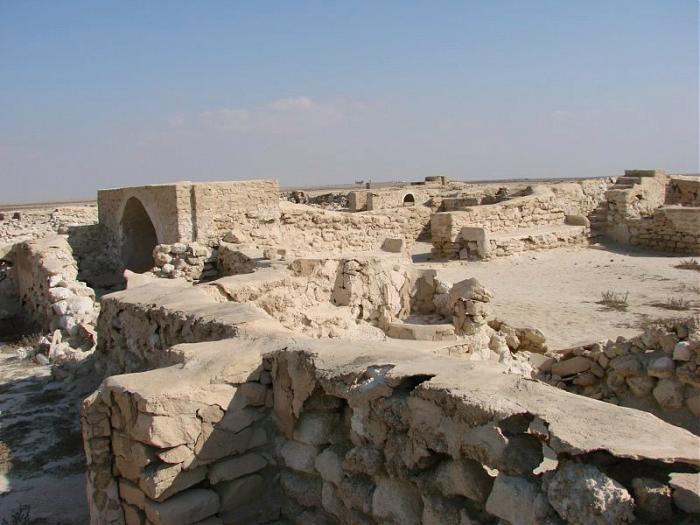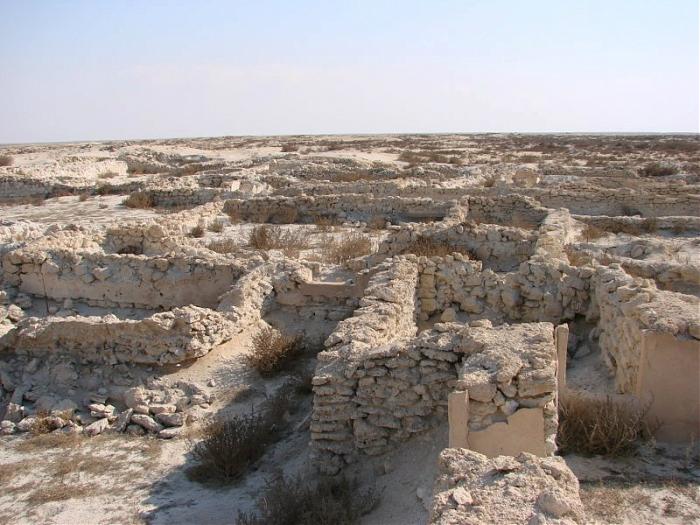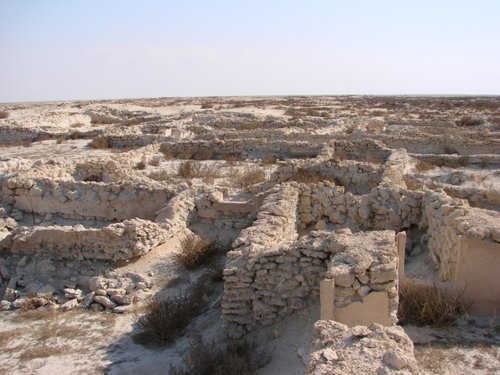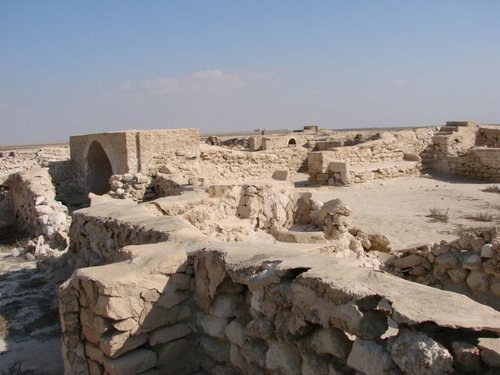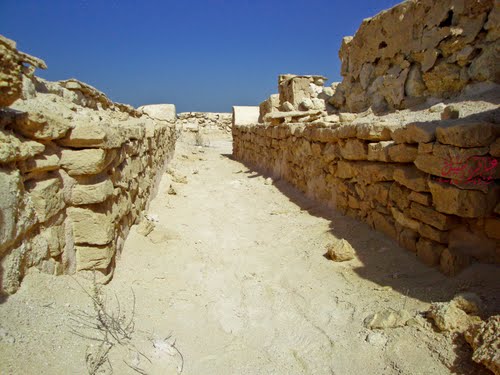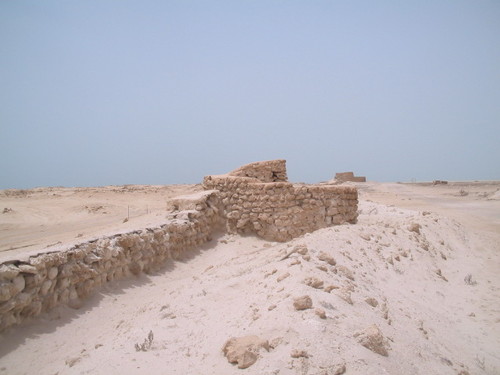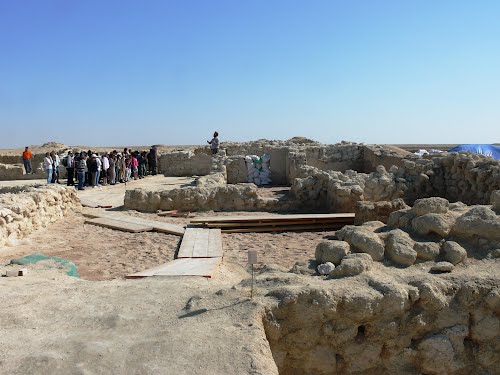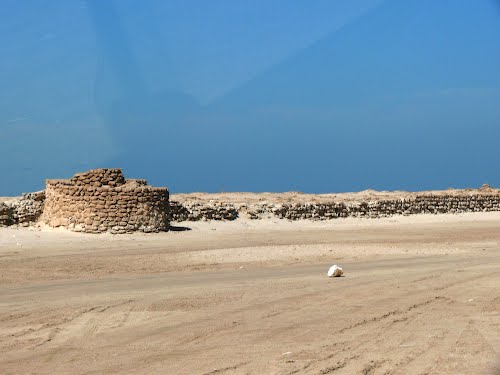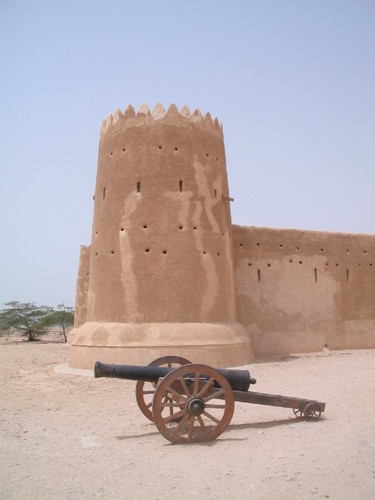Zubarah, also referred to as Al Zubarah or Az Zubarah, is a ruined and deserted town located on the north western coast of the Qatar peninsula in the Madinat ash Shamal municipality, about 105 km from the Qatari capital of Doha. It was founded by Al Bin Ali , main and principal Utub tribe in the first half of the eighteenth century. It was designated a UNESCO World Heritage Site in 2013.
It was once a successful center of global trade and pearl fishing positioned midway between the Strait of Hormuz and the west arm of the Persian Gulf. It is one of the most extensive and best preserved examples of an 18th–19th century settlement in the region. The layout and urban fabric of the settlement has been preserved in a manner unlike any other settlements in the Persian Gulf, providing an insight into the urban life, spatial organization, and the social and economic history of the Persian Gulf before the discovery of oil and gas in the 20th century.
Covering an area of circa 400 hectares, Zubarah is Qatar’s most substantial archaeological site. The site comprises the fortified town with a later inner and an earlier outer wall, a harbour, a sea canal, two screening walls, Qal'at Murair, and the more recent Zubarah Fort.
History
Early history
The name "Zubarah" is derived from the Arabic word for sand mounds. It was presumably given this name due its abundance of sand and stony hillocks. During the early Islamic period, trade and commerce boomed in northern Qatar. Settlements began to appear on the coast, primarily between the towns of Zubarah and Umm al-Ma'a. A village dating back to the Islamic period was discovered near the town.
Between September 1627 and April 1628, a Portuguese naval squadron led by D. Goncalo da Silveira set a number of neighboring coastal villages ablaze. Zubarah's settlement and growth during this period is attributed to the dislodging of people from these adjacent settlements.
Initial settlement (17th and 18th century)
Arrival of Al Bin Ali Utub
There remains some uncertainty over the earliest mention of Zubarah in written documents. Qatar's Memorial, a 1986 Arabic history book, alleges that a functional self-governing town existed before the arrival of the Utub. It supported this claim by invoking two purported historical documents, but they were later discovered to be forgeries produced by Qatar in an attempt to gain leverage over Bahrain in their long-standing dispute over the sovereignty of the town.
Zubarah was founded and ruled by the Al Bin Ali tribe, whom have migrated from Kuwait to Zubarah in 1732, helping to build a large town characterized by a safe harbour. It soon emerged as one of the principal emporiums and pearl trading centres of the Persian Gulf.
Al Bin Ali rule of Zubarah
The Al Bin Ali, migrated from Kuwait and settled at Zubarah in 1732, founded and ruled the town of Zubarah, and its port making it one of the most important port and pearl trading centers in the Persian Gulf in the 18th Century. They also expanded their settlements, and constructed walls and a fort outside the town of Zubarah called Qal'at Murair, the name is derived from a water spring in the Bani Sulaim area next to Madina Al Munawara in today's Saudi Arabia also known as Herat Bani Sulaim.
The Al Bin Ali were the original dominant group controlling the town of Zubarah on the Qatar peninsula, they were a politically important group that moved backwards and forwards between Qatar and Bahrain, originally the center of power of the Bani Utbah. The Al Bin Ali they were also known for their courage, persistence, and abundant wealth.
The Al Bin Ali had a practically independent status in Bahrain and Qatar as a self-governing tribe. They used a flag with four red and three white stripes with seven triangles facing the west, called the Al-Sulami flag in Bahrain, Qatar, Kuwait, and the Eastern province of the Kingdom of Saudi Arabia.
Under their jurisdiction, the town developed trade links with India, Oman, Iraq and Kuwait. Many goods were transported through its ports, including dates, spices and metals. The town soon became a favorite transit point for traders after the Utub abolished trade taxes. The town's prosperity further increased after the 1775–76 Persian occupation of Basra when merchants and other refugees fleeing from Basra settled in Zubarah.
Ongoing wars between Bani Khalid and the Wahhabis and Persian invasion of Basra were among the factors that helped Al Zubara flourish into an important trade center. This prominent position led to conflicts with adjacent port towns.
Merchants from nearby settlements migrated to Zubarah en masse during the 1770s due to the prevalence of attacks and the plague in the Persian Gulf region.
Siege of Zubarah 1783
A quarrel arose in 1782 between the inhabitants of Zubarah and Persian-ruled Bahrain. Zubarah natives traveled to Bahrain to buy some wood, but an altercation broke out and in the chaos an Utub sheikh's slave was killed. The Utub and other Arab tribes retaliated on 9 September by plundering and destroying Manama. A battle was also fought on land between the Persians and the Arab tribes, in which both sides suffered casualties. The Zubarans returned to the mainland after three days with a seized Persian gallivat that had been used to collect annual treaty. On 1 October, Ali Murad Khan ordered the sheikh of Bahrain to prepare a counter-attack against Zubarah and sent him reinforcements from the Persian mainland.
Bani Utbah's victory over Nasr Al-Madhkur at Zubarah in 1783
In 17 May 1783, war broke out between the Zubarah-based Al Bin Ali Bani Utbah tribe and the and the army of Nasr Al-Madhkur. Zubarah was originally the center of power of the Al Bin Ali Bani Utbah tribe, which was ruling Zubarah and the original dominant tribe in Zubarah. About 2,000 Persian troops arrived in Bahrain by December; they then attacked Zubarah on 17 May 1783. After suffering a defeat, the Persians withdrew their arms and retreated to their ships. An Utub naval fleet from Kuwait arrived in Bahrain the same day and set Manama ablaze. The Persian forces returned to the mainland to recruit troops for another attack, but their garrisons in Bahrain were ultimately overrun by the Utub.
It is well known that the strategist of this battle was Shaikh Nasr Al-Madhkur, his sword fell into the hands of Salama Bin Saif Al Bin Ali after his army collapsed and his forces were defeated.
The Al Bin Ali, have kept the sword with them and they kept passing it from son to grandson until it was given as a gift to King Abdul Aziz Bin Faisal Al Saud and it can be seen today at the King AbdulAziz Museum in Riyadh, Capital of Saudi Arabia.
The Original Utub Al Bin Ali conquered and expelled the Persians from Bahrain after defeating them in the battle of Zubarah that took place in the year 1782 between the Al Bin Ali and the Army of Nasr Al-Madhkur Ruler of Bahrain and Bushire. The Bani Utbah was already present at Bahrain at that time, settling there during summer season and purchasing date palm gardens.
Despite the instability surrounding Zubarah after the siege of Zubarah and the conquest of Bahrain in 1783, it flourished as a trading centre and its port grew to be larger than that of Qatif's by 1790. Al Zubarah developed into a center of Islamic education during this century.
The town came under threat from 1780 onward due to the intermittent raids launched by the Wahhabi on the Bani Khalid strongholds in nearby Al-Hasa. The Wahhabi speculated that the population of Zubarah would conspire against the regime in Al-Hasa with the help of the Bani Khalid. They also believed that its residents practiced teachings contrary to the Wahhabi doctrine, and regarded the town as an important gateway to the Persian Gulf. Saudi general Sulaiman ibn Ufaysan led a raid against the town in 1787. In 1792, a massive Wahhabi force conquered Al Hasa, forcing many refugees to flee to Zubarah. Wahhabi forces besieged Zubarah and several neighboring settlements two years later to punish them for accommodating asylum seekers. The local chieftains were allowed to continue carrying out administrative tasks but were required to pay a tax.
Communal life
Zubarah was at that time a well-organised town, with many of the streets running at right angles to one another and some neighbourhoods built according to a strict grid pattern. This layout suggests that the town was laid out and built as part of a major event, although seemingly constructed in closely dated stages. An estimate of the population at the height of the town has been calculated to a maximum number of between 6,000 and 9,000 people.
Most of the settler's dietary requirements were fulfilled from the consumption of livestock animals. Remnants of sheep, goat, birds, fish and gazelle were among the waste collected from the palatial compounds. The wealthiest members of the community consumed mainly livestock, whereas the poorer residents relied on fish as their primary source of protein. Social, economic and political activity was most likely centered in the souq. The discovery of numerous ceramic tobacco pipe bowls indicate a reluctant acceptance and growing social addiction to smoking tobacco. Coffee pots, mainly of Chinese origin, were used by Zubarah's inhabitants to drink Arabic coffee.
Later developments and decline (19th century)
The town was occupied by the Wahhabi in 1809. After the Wahhabi amir was made aware of advancements by hostile Egyptian troops on the western frontier in 1811, he reduced his garrisons in Bahrain and Zubarah in order to re-position his troops. Said bin Sultan of Muscat capitalized on this opportunity and attacked the Wahhabi garrisons in the eastern peninsula. The Wahhabi fortification in Zubarah was set ablaze and the Al Khalifa were effectively returned to power. Following the attack, the town was abandoned for a short period. However, later archaeological discoveries indicate that the town may have been partially abandoned shortly before the 1811 attack.
From c. 1810 onwards, the British Empire became more influential in the Persian Gulf area, stationing political agents in various ports and cities to protect their trading routes.
Zubarah was eventually resettled in the late 1820s. It remained a pearl fishing community, but on a significantly smaller scale than previously. The reconstructed town barely covered 20% of its predecessor. A new town wall was constructed much closer to the shore than the earlier town wall. This phase of Zubarah was not as organized in the layout of the streets and its buildings. Houses were still built in the traditional courtyard form, but on a smaller scale and more irregular in their shape. Additionally, evidence of decorated plaster known from earlier buildings were not found in the newly constructed buildings.
In 1868, the Al Khalifa launched a major naval attack on the eastern portion of Qatar. In the aftermath of this attack, a sovereignty treaty was signed between the Al Thani and the British, uniting the entire Qatari Peninsula under the leadership of the Al Thani. Nearly all of the authority that the Al Khalifa held in Zubarah was diminished, with the exception of informal treaties they had signed with a few local tribes.
Abandonment (20th and 21st century)
Much of the remaining population migrated to other regions in Qatar in the early 20th century due to the inadequate water supply in the town.
In 1937, a conflict broke out between Qatari loyalists and the Naim tribe who had defected to Bahrain, precipitating Bahrain's subsequent territorial claims to Zubarah. A recent proposal that Zubarah become an oil terminal was a contributing factor in the conflict. Qatar's emir, Abdullah bin Jassim alleged that Bahrain provided assistance to the Naim in the form of arms and finances. That year, in the aftermath of the conflict and subsequent out-migration,
Abdullah bin Jassim commenced the construction of Zubarah Fort to compensate for the reduced garrison. It was completed in 1938. Qal'at Murair, the hitherto principal fort of the town, was abandoned soon after Zubarah Fort was erected.
In the mid 20th century, the political adviser in Bahrain, Charles Belgrave, reported that just a few Bedouin of the Nua‘imi tribe lived, albeit nomadically, in the ruined town. The area was gradually abandoned towards the end of the 20th century and was used primarily for beach camps. The fort also housed a coast guard station until the 1980s.

